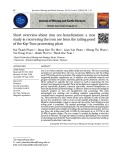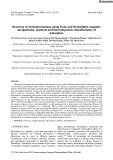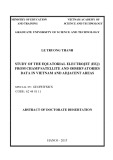
Magnetic separation
-
The article shows a short review of the main methods in order to treat the type of raw material as well as some current applied technology in Vietnam. Based on the knowledge,a study to recover the iron of Kip-Tuoc tailing from the tailing pond is presented. The applied technology is the combination of a trommel screen, spiral and shaking table.
 14p
14p  viyoko
viyoko
 01-10-2024
01-10-2024
 2
2
 1
1
 Download
Download
-
Harvesting microalgae by centrifugation and filtration is very costly, affecting technical and economical feasibility of downstream processing of algal biomas to bioproducts. Flocculation is a potential technique for recovery of algae biomass. Particularly, flocculation using magnetic nanoparticles offers high separation efficiency due to their high surface area and magnetic properties. I
 10p
10p  dianmotminh02
dianmotminh02
 03-05-2024
03-05-2024
 5
5
 1
1
 Download
Download
-
Research objectives: Collect and process the magnetic data from CHAMP satellite and from the magnetic observatories within 6 years (from 2002-2007); study the method to separate magnetic field caused by EEJ from the observed data; identify some parameters of EEJ in all over meridians and study the variation of EEJ in space and time. The variation of EEJ in longitude, latitude and local time.
 26p
26p  change03
change03
 06-05-2016
06-05-2016
 44
44
 2
2
 Download
Download
-
Oil absorbent nanocomposites were prepared by suspension copolymerization of laurylmethacrylate (LMA) and styrene (St) with and whithout Fe3O4 nanoparticles and divinylbenzene (DVB) crosslinker. The magnetic composite resin can be recovered after conveniently and rapidly absorbing oil by magnetic separation techniques without excluding other mechanical techniques.
 6p
6p  uocvong01
uocvong01
 24-09-2015
24-09-2015
 32
32
 3
3
 Download
Download
-
The most widely used analytical separation technique for the qualitative and quantitative determination of chemical mixtures in solution in the pharmaceutical industry is high-performance liquid chromatography (HPLC). However, conventional detectors used to monitor the separation, such as UV, refractive index, fluorescence, and radioactive detectors, provide limited information on the molecular structure of the components of the mixture. Mass spectrometry (MS) and nuclear magnetic resonance (NMR) are the primary analytical techniques that provide structural information on the analytes.
 36p
36p  bigbaby87
bigbaby87
 03-09-2010
03-09-2010
 120
120
 16
16
 Download
Download
CHỦ ĐỀ BẠN MUỐN TÌM

















